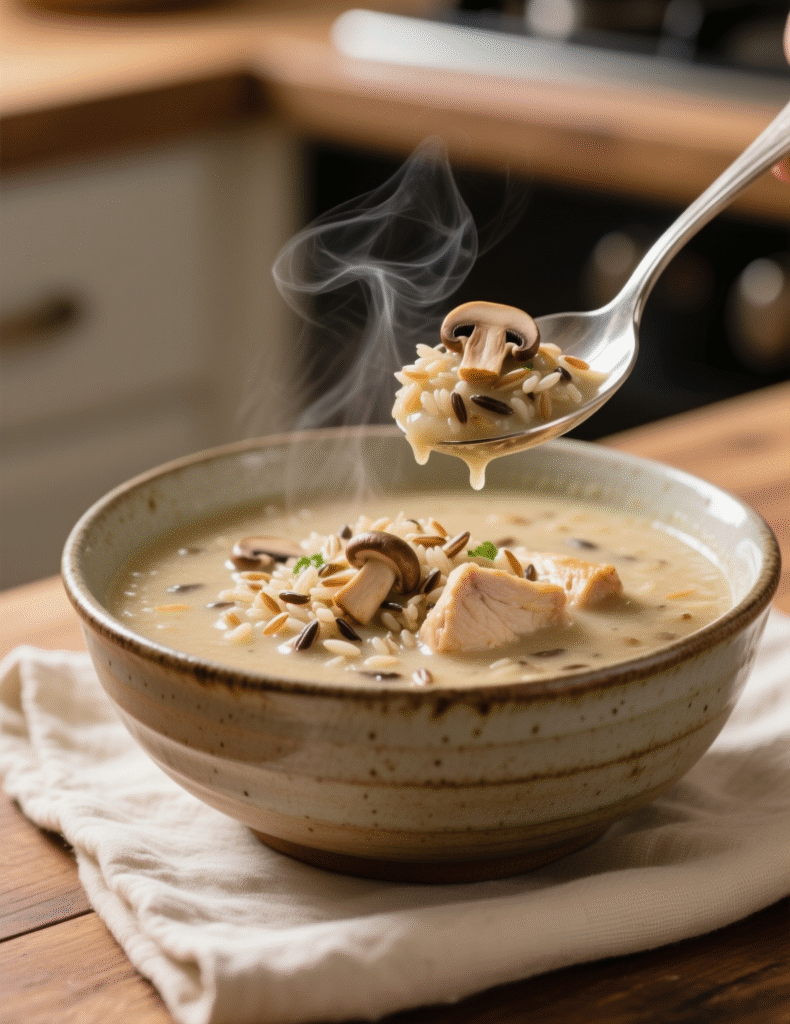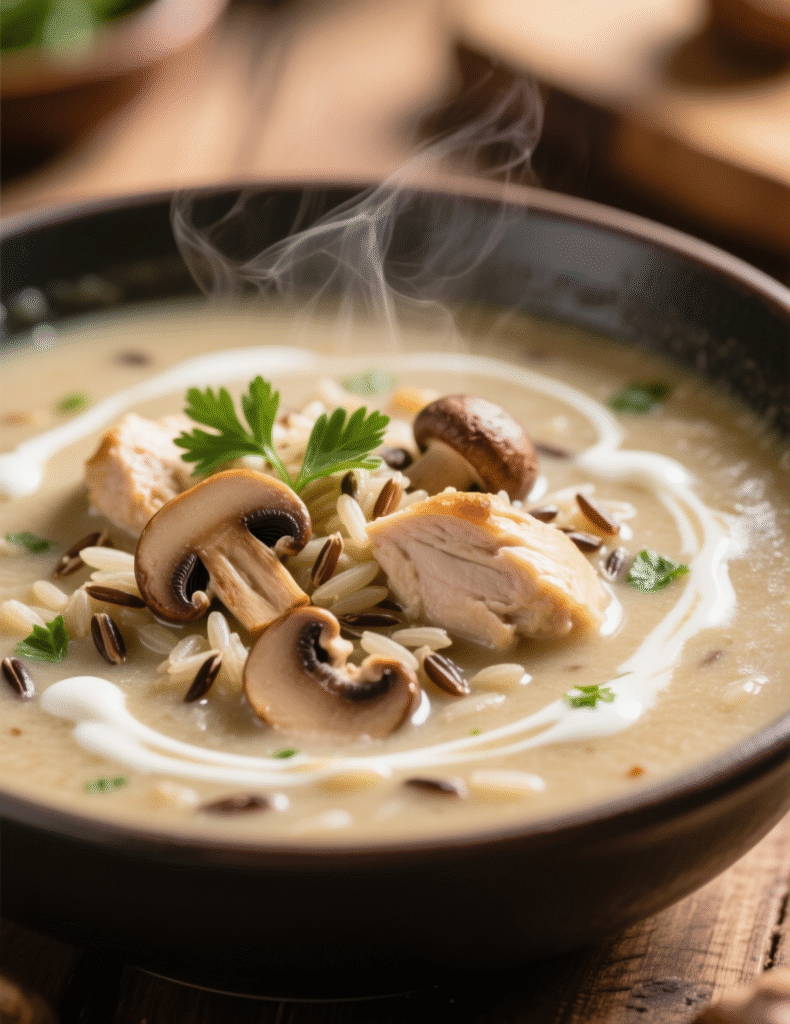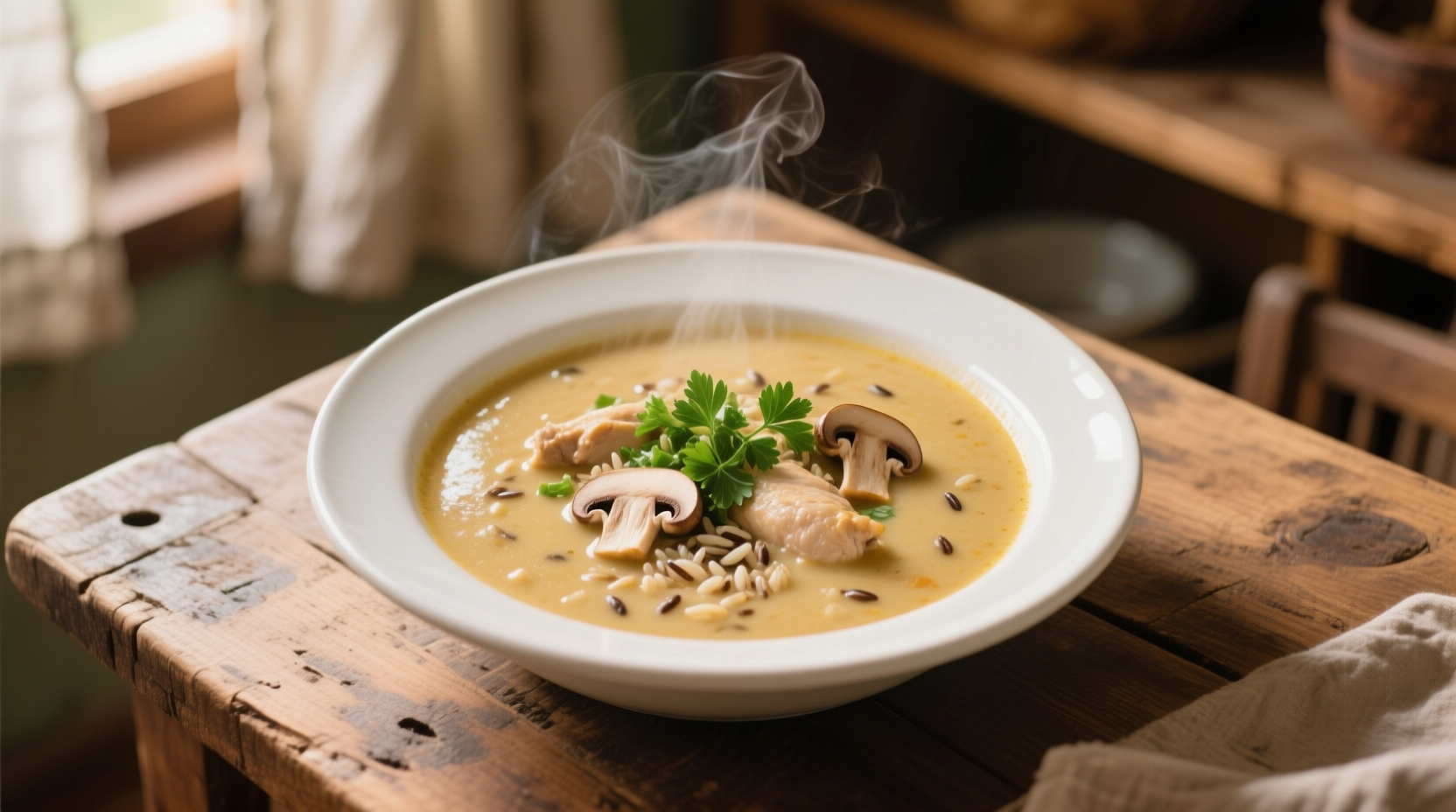There’s something about a bowl of creamy mushroom chicken & wild rice soup that hits different. It’s not just warm food—it’s a layered story of texture, aroma, and technique. This isn’t your average dump-and-stir weeknight meal; it’s a recipe that challenges you to respect ingredients, balance flavors, and treat each step as craft.
Why This Soup Stands Out
Chicken soup is a dime a dozen. Mushroom soup—plenty of versions out there too. But when you marry both with the nutty backbone of wild rice, you get depth that borders on gourmet while staying comfortingly familiar. The earthiness of mushrooms acts like bass notes in music. Cream layers on harmony. And rice, well, it’s the heartbeat.
Professional kitchens know this combination plays well across seasons. In colder months, its creaminess comforts; in warmer weather, its light umami edge still carries appeal. That’s versatility you don’t see in every soup.
Understanding Wild Rice at Its Core
Wild rice isn’t rice at all. Botanically, it’s the seed of aquatic grass. It grows naturally in North American lakes and rivers, harvested historically by Indigenous peoples who considered it a sacred food. Compared to white rice, it’s denser, chewier, and carries a roasted, slightly smoky bite.
Nutritionally, wild rice offers double the protein of white rice, fewer calories, and nearly triple the fiber. It’s also rich in antioxidants—studies from the Journal of Agricultural and Food Chemistry confirm high levels of phenolic acids, which fight oxidative stress. That’s not just filler grain in your soup. That’s a powerhouse.
Mushrooms: The Umami Workhorse
Mushrooms, especially cremini or shiitake, elevate soups far beyond “comfort food.” The glutamates in mushrooms naturally enhance savory perception. They don’t overpower; they amplify. This makes them crucial in professional kitchens where flavor layering is non-negotiable.
A 2021 USDA study pointed out that mushrooms are the only produce source of natural vitamin D when exposed to UV light. Add that to the soup and you’re feeding both body and soul. Professionals know the trick: sauté mushrooms until the water cooks off and they caramelize. That browning, not just softness, makes the difference.
Choosing the Right Chicken
Don’t fall into the boneless, skinless chicken breast trap. Flavor lives in the bones and skin. A mix of bone-in thighs and breast gives best results. Thighs bring fat and richness; breast balances with lean protein.
Chefs often poach the chicken separately in stock, skim the fat, and fold shredded meat back into the final pot. That keeps the texture precise—no stringy mess.
Building the Cream Base
Cream-based soups are tricky. Too much cream and you drown flavors. Too little and you end up with a broth pretending to be luxurious. The pro move? Start with a roux. Equal parts butter and flour cooked until lightly golden, then slowly whisked with stock.
This not only thickens but stabilizes the final soup. When you stir in cream or half-and-half at the end, it won’t split. French culinary schools teach that technique on day two. It matters.

A Professional Breakdown of the Cooking Process
- Prep the wild rice first. It takes 45–50 minutes to cook properly. Simmer in salted water or stock until chewy but not mushy.
- Sear the mushrooms hard. Don’t crowd the pan or they’ll steam. Give them space and patience.
- Poach the chicken. Keep the poaching liquid—this becomes your stock foundation.
- Build your mirepoix. Onion, carrot, celery, maybe a hint of leek. Sweat them slowly in butter.
- Roux and stock integration. Don’t rush. Gradually whisk stock into roux.
- Combine components. Wild rice, shredded chicken, mushrooms, mirepoix—all folded in.
- Finish with cream. Add off heat to prevent curdling. Season with thyme, bay, pepper, maybe a dash of nutmeg.
Every step protects texture. That’s what separates this soup from shortcuts you’ll find online.
Common Mistakes to Avoid
One big mistake? Adding rice too early. It bloats, bursts, and turns the pot into starchy sludge. Cook separately, fold late.
Another? Overcooking cream. Dairy breaks when boiled. Professionals finish the soup with cream at serving stage.
And maybe the most overlooked—seasoning only at the end. Each layer (mushroom, stock, mirepoix) needs its own seasoning. Salt isn’t just salt; it’s a thread that ties flavors.
Variations That Work
For a leaner approach, swap heavy cream with evaporated milk. For more complexity, add a splash of dry sherry or Marsala when deglazing mushrooms. That fortified sweetness pairs beautifully with umami.
Vegetarians can sub chicken with cannellini beans or smoked tofu. Smoked paprika or liquid smoke can mimic the savory edge.
And for the ambitious? Use a mix of mushrooms—shiitake, porcini, oyster—for an earthy symphony.
Nutritional Insights
A standard serving (about 1½ cups) of creamy mushroom chicken & wild rice soup delivers roughly:
- 320–380 calories
- 24g protein
- 12–15g fat (depending on cream use)
- 28g carbs
- 4–5g fiber
That’s a balanced profile—protein for satiety, fiber for digestion, fat for flavor. Unlike cream-of-something canned soups, this is real nourishment.
How Professionals Elevate Presentation
In professional kitchens, soup isn’t just ladled—it’s plated. Use wide shallow bowls, garnish with a drizzle of herb oil, a few fried mushroom slices, or microgreens. Presentation shifts perception from “rustic comfort” to “refined dining.”
A trick many chefs use is finishing with acid—lemon juice or a splash of white wine vinegar right before serving. Acid wakes up cream-heavy dishes, making them taste lighter than they are.
Emerging Trends: The Rise of Functional Comfort Foods
Globally, there’s a growing demand for foods that feel indulgent but serve health. Mushroom chicken wild rice soup fits right in. Functional mushrooms like lion’s mane and reishi are already creeping into menus, touted for brain and immune health.
In high-end restaurants, chefs are experimenting with plant-based creams (cashew, oat) to meet dairy-free needs. The challenge is replicating the silky mouthfeel of dairy while maintaining authenticity. Some are nailing it.
The Soul of the Soup
At its heart, this soup is slow food. You can’t rush wild rice. You can’t fake mushroom caramelization. You can’t shortcut flavor extraction from bones. Professionals respect these timelines because shortcuts cheapen the dish.
Food like this reminds us why cooking is craft. It rewards patience with complexity in every spoonful.
Expert Tips That Change the Game
- Toast wild rice in butter before simmering—deepens nutty notes.
- Use a mushroom stock base if going vegetarian.
- Add fresh herbs at the very end; cooking them too long dulls their edge.
- Always let the soup rest 10 minutes before serving; flavors marry in those quiet minutes.

Conclusion: A Bowl Worth Mastering
Creamy mushroom chicken & wild rice soup isn’t just a recipe—it’s a training ground. It teaches patience, layering, precision, and respect for ingredients. It feeds both appetite and skillset.
If you’re cooking for yourself, it’s comfort. If you’re cooking for others, it’s a show of care. For professionals, it’s proof that even humble ingredients can form something extraordinary when treated right.
So next time you pull mushrooms from the fridge and see that bag of wild rice, think beyond basics. Build something layered, creamy, and soulful. This isn’t soup—it’s story in a bowl.
FAQs
What makes creamy mushroom chicken & wild rice soup unique?
The blend of earthy mushrooms, tender chicken, and nutty wild rice creates depth that’s both comforting and refined.
Can I substitute wild rice with regular rice?
Yes, but wild rice offers a chewier texture and richer flavor than white or brown rice.
What type of mushrooms work best in this soup?
Cremini, shiitake, or a mix of wild mushrooms give the best umami depth.
How do I prevent the cream from curdling?
Add cream off heat at the end and avoid boiling after dairy is added.
Should I cook the rice separately?
Yes, cooking it separately keeps the soup from becoming starchy and thick.
Can I make this soup vegetarian?
Absolutely—swap chicken for beans or tofu and use mushroom or vegetable stock.
Is this soup freezer-friendly?
It freezes well if you leave out the cream and add it fresh when reheating.
How long does the soup keep in the fridge?
Stored properly, it lasts 3–4 days without losing quality.
What’s the best chicken cut for this recipe?
Bone-in thighs add richness, while a mix of thigh and breast balances flavor and texture.
How can I elevate presentation?
Serve in wide bowls and garnish with herb oil, fried mushrooms, or microgreens for a refined touch.

Mariana is a passionate home cook who creates delicious, easy-to-follow recipes for busy people. From energizing breakfasts to satisfying dinners and indulgent desserts, her dishes are designed to fuel both your body and hustle.
When she’s not in the kitchen, she’s exploring new flavors and dreaming up her next recipe to share with the Foodie Hustle community.

